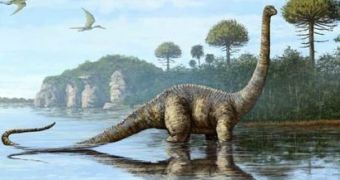Access to lots of food and room to wander as one sees fit definitely helped plant-eating dinosaurs grow to impressive sizes. Still, researcher Matthew Bonnan with The Richard Stockton College of New Jersey and his colleagues believe that, all things considered, the shape of these animals' joints also had a say in the matter.
In a recent paper in the journal PLOS ONE, the researchers detail that, after analyzing the fossil remains of several herbivorous dinosaurs, they found that, the bigger the animal was, the wider and the flatter the ends of its limb bones were.
What's more, they say that, according to their measurements, the area between the end of one bone and the end of another was large enough to accommodate for several layers of cartilage.
This means that, unlike other creatures, these ancient reptiles had surprisingly squishy joints, Live Science tells us.
Matthew Bonnan and his colleagues theorize that, thanks to their shape and the fact that they packed several layers of cartilage, the dinosaurs' joints were able to withstand noteworthy amounts of pressure and therefore made it possible for these animals to grow as big as they did.
“Frequent gigantism in saurischian dinosaurs may be explained, in part, by joints with thick articular cartilage that can deform across large areas with increasing load,” the researchers write in the Abstract to their paper.
“More than just evenly distributing the pressure, the joint itself may be deforming a little — it’s actually squishier, increasing the force it can sustain,” specialist Matthew Bonnan goes on to detail.
By comparison, investigations have shown that the ends of a mammal's bones tend to become more rounded and house less cartilage between them as the animal's size increases.
Hence the fact that the run-off-the-mill mammalian joint cannot support too much weight and that the biggest land-based mammals ever to walk the Earth never stood a chance to grow as big as dinosaurs did.

 14 DAY TRIAL //
14 DAY TRIAL //